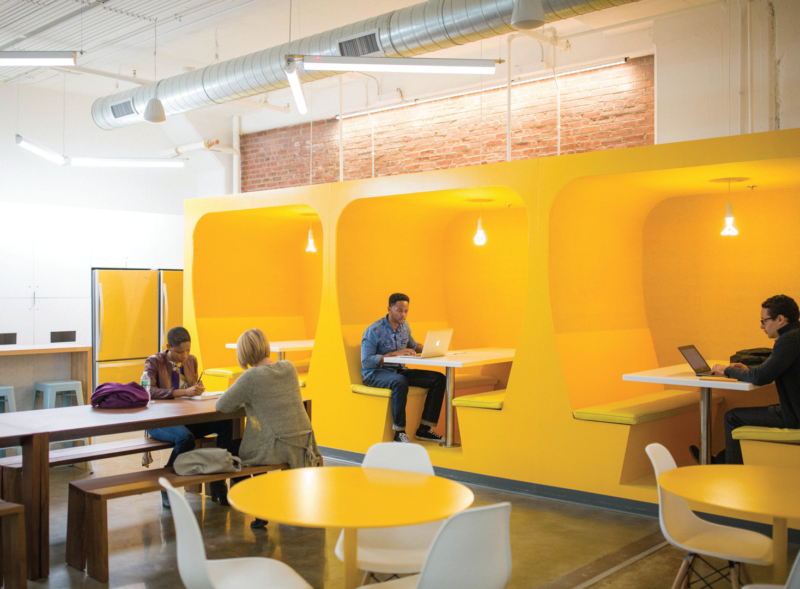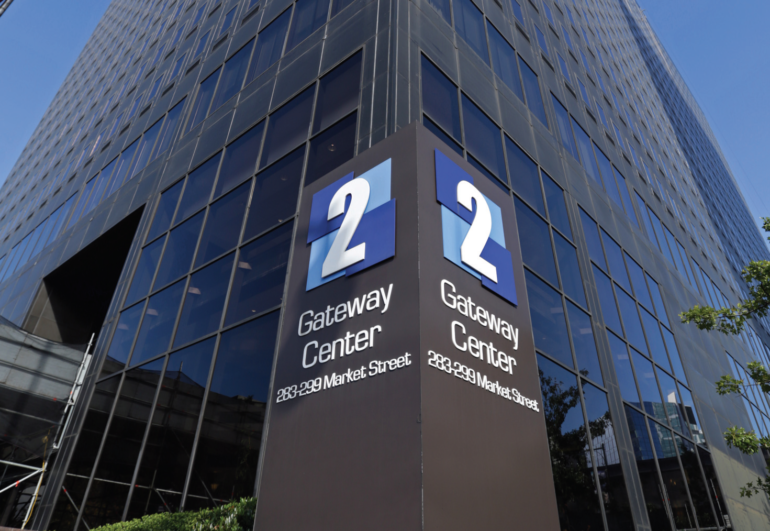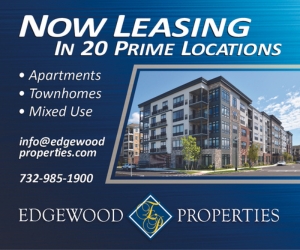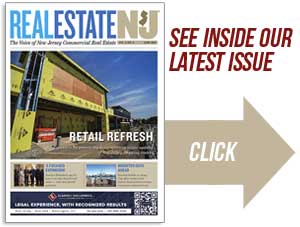C&K Properties’ 2 Gateway Center in Newark was the first building in New Jersey to achieve a WiredScore platinum rating when it was certified in 2014. — Courtesy: C&K Properties
By Joshua Burd
In their effort to draw new tenants to 2 Gateway Center, an 18-story office tower in downtown Newark, C&K Properties and its brokers have sought to highlight the building’s high-speed internet, backup power and superior connectivity.
But Kevin Collins concedes that “landlords are a self-interested party,” meaning they’re not afraid to embellish when trying to lease their space.
That made it all too important for the ownership team to seek a certification from WiredScore, a company that rates buildings based on their internet connectivity and other facets of their digital infrastructure.
The landlord achieved a platinum designation under the rating system in 2014, making it the first commercial building in the state to do so.

“We were looking for validation, if you will, of the investment that we had made, because we understood how valuable it could be to a tenant,” said Collins, C&K’s managing director for asset management and finance. “We needed a way to communicate that to tenants that they could then have some confidence in and give some credibility to.”
The 800,000-square-foot tower is among fewer than 30 buildings in New Jersey that have attained Wired Certification, but that could soon change. The rating service earlier this year released a full-fledged set of guidelines, providing a roadmap for professionals involved in new commercial developments.
And with the growing importance of data and internet connectivity, the rating system offers the potential to play a major role in office leasing going forward. Some experts say it could follow the path of what’s commonly known as LEED certification, the U.S. Green Building Council’s guidelines for sustainable design, which have become all but essential for newly built or renovated properties.
WiredScore, which grew out of a program launched by former New York City Mayor Michael Bloomberg, released its 42-page guidelines in March. Its founder said the organization developed the criteria based on evaluation of more than 900 commercial office buildings across the U.S. and United Kingdom, while also relying on input from experts in the commercial real estate, technology and telecommunications sectors.
Previously, existing buildings such as 2 Gateway earned their certification by submitting to an audit from WiredScore. The company has also worked with development teams during the design phase for new buildings and properties undergoing major renovations, but the newly prepared guidelines are meant to simplify that process and push technology further to the forefront of the design process for architects, engineers and others involved in development.
For instance, the document, which was written with the end user in mind, offers guidance in areas such as mobile capacity planning, conduit points of entry and electrical resiliency.

“After working with 100-plus building owners across the country, we identified the fact that there’s really no kind of voice in the marketplace as to how buildings should be constructed from a connectivity perspective,” said Arie Barendrecht, founder and CEO of WiredScore. “So we wanted to not just be the people evaluating buildings, but also telling building owners how they should be thinking about this proactively and make that publicly available for anybody to access.”
Barendrecht also said the guidelines are meant to show owners how they can maintain the flexibility needed to adopt new building technologies in the future, creating a comfort level for developers who want to ensure the infrastructure is still modern when they deliver a building.
WiredScore has certified nearly 320 million square feet worth of property across the U.S. since 2013. About 28 buildings in New Jersey have become Wired Certified, and Barendrecht said the organization is working with both existing clients and new landlords who are pursuing the certification.
RELATED: Here are WiredScore’s top adopters in New Jersey (and a breakdown of how it works)
The opportunity has played a key role in C&K Properties’ effort to reposition 2 Gateway over the past three years. The building was left with some 360,000 square feet of vacant space by 2015, thanks largely to the departure of Prudential Financial, which consolidated multiple offices into a newly built tower nearby. In marketing to new tenants, C&K has sought to highlight the building’s direct connection to Newark’s network of fiber optic cable and the ability to offer high-speed, low-cost internet access.
In fact, Dudley Ryan, who heads the leasing team for 2 Gateway, said “we see fiber optics and connectivity becoming more and more important as essentially a utility.” He added: “Bottom line: buildings that are not connected are not going to be considered for today’s typical tenants.”

“Everybody is required to move more data,” said Ryan, a senior vice president with CBRE. “That’s the curve, that’s where things are generally going, so with the ability to expedite that movement, you’re just that much further ahead of your competition as a tenant within their own industry and more so as a building compared to others.”
Connectivity is especially critical for sectors such as financial technology, or fintech. The 2 Gateway team proved that earlier this year when it inked a 160,000-square-foot lease with Broadridge Financial Solutions Inc., a provider of technology, managed services, data and other solutions. The company, which is relocating from Jersey City, is the first new major tenant to take advantage of 2 Gateway’s connections to Newark’s fiber infrastructure.
“It certainly served as a platform for us to be able to share the breadth of the building’s capabilities,” Collins, the C&K executive, said of the correlation between 2 Gateway’s Wired Certification and the lease with Broadridge. “It quantifies exactly what we can provide, which we think is an advantage when you’ve got a better product.”
Other landlords have pursued WiredScore designations in hopes of appealing to so-called TAMI tenants, an acronym for technology, advertising, marketing and information. In 2015, Mack-Cali Realty Corp. announced that three of its waterfront office buildings in Jersey City — Harborside Plaza 2, 101 Hudson Street and Harborside Plaza 5 — had achieved platinum-level certification.
“In today’s business environment, tenants, especially in the TAMI sector, need to know that they will have access to the best internet providers who offer the fastest connection speeds,” Christopher DeLorenzo, Mack-Cali’s executive vice president of leasing, said at the time. “This distinction validates our commitment to providing state-of-the-art technology that meets the needs of a changing tenant base and provides protection against outages and business disruption.”
Developers are also seeking Wired Certification when converting former industrial properties. In early May, Edison Properties said it was seeking platinum status as part of its plan to redevelop a warehouse in Newark into 456,000 square feet of modern, loft-style office space. In Kearny, developer Hugo Neu has pursued the designation in the opening of a new 20,000-square-foot co-working space, part of a massive redevelopment of a former shipyard in the town.

Collins said Wired Certification was essentially a seal of approval that 2 Gateway could display to technology-minded users. But he said it was equally important that the service provides a set of standards that allows tenants to compare buildings on a technology infrastructure basis.
It’s akin to the U.S. Green Building Council’s Leadership in Energy and Environmental Design standards, also known as LEED certification.
“So it’s not just a claim — there’s some independent body out there that has said, ‘These are the things that are important, and if you check all the boxes, then that means something,’ ” Collins said, later adding: “The value that they really have is that it gives a tenant the ability to make an objective choice.”
If WiredScore follows the path of the LEED program, the certification could ultimately become a de facto requirement for newly built office buildings. The USGBC established the LEED system in 2000 as a way of identifying best practices for energy efficiency, healthy building materials and environmental quality, among other standards.
That has given way to what has become a sought-after designation by top developers and tenants who are environmentally and socially conscious. William Amann, a former chair of the U.S. Green Building Council New Jersey, said the feeling among elite office landlords is that LEED certification has “gone from a selling point to a box that needs to be checked — it’s just expected.”

“If the tenants weren’t interested in this, I doubt the developers would be,” said Amann, president of M&E Engineers Inc. in Somerville. “But the more savvy developers saw it is as an opportunity to differentiate their properties and it’s become so well-known and pervasive that it’s now a requirement.”
Barendrecht has already seen at least one very noticeable difference as a result of the new WiredScore guidelines. He said the process of “value engineering” during a design phase — which can entail cutting costs or cutting certain design elements in order to maximize space — can result in cuts to a project’s technology and telecom infrastructure.
But “one of the biggest pieces of positive feedback we’re getting from engineers” is that during that value engineering process, they now have a set of standards to fall back on and make the case for preserving those technology assets.
“The engineers can raise their hand and say, ‘We’re building to Wired Certification specs, which means we can’t change some of those things that we originally scoped in. They have to stay in the building design because we want to make sure that our building is state-of-the-art from a technology perspective,’ ” Barendrecht said.
“That’s a really big change in behavior, where these things were getting kind of cut out of the building schematics in years past, and now they’re making it all the way into the final building design because the engineers have something to stand behind, which is our guidelines.”
Added value
As to whether being Wired Certified can translate into higher rents, Kevin Collins said there is no measurable correlation at 2 Gateway. Rather, he sees it as added value for a tenant and a differentiator when the building can offer superior connectivity and infrastructure.
For instance, tenants can access speeds of 10 gigabits per second, which dwarfs typical internet connections. And 2 Gateway’s location in Newark allows it to do so at 20 percent of the typical cost, which Collins said “goes into their cost of doing business and is just something else that they factor into the competitive set that they’re looking at.”
That’s especially important, given that virtually every tenant today is internet-dependent, Collins said. It’s not simply companies such as Google, Facebook and like-minded tech startups.
“What that means to a tenant is you don’t need file cabinets, you don’t need internal servers to hold really large documents and sets of data, because now with this type of connectivity and bandwidth, you can put everything in the cloud,” Collins said. “So that means that in addition to the savings you get because our floorplates are so efficient, you now don’t need as much space because you just don’t need as much equipment.
“You can now access all of that data that much more quickly. So it makes sense to not have it on site, either in the form of paper or in the form of a computer server, and that’s a real savings.”










